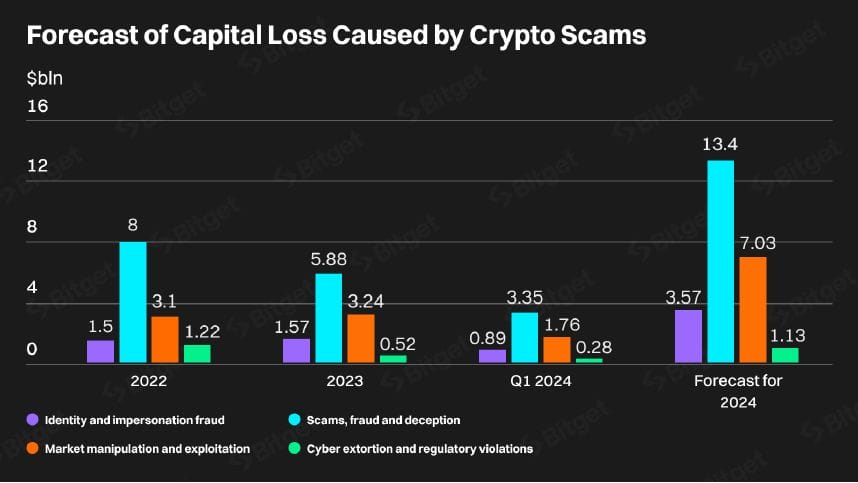Deepfake Crypto Scams to Double, Surpassing $25B in 2024

Crypto losses due to deepfake crypto scams are set to exceed $25 billion in 2024, more than doubling last year’s losses, according to Bitget.
In a June 27th Bitget report, the crypto exchange noted a 245% increase in the number of deep fakes worldwide in 2024, drawing from earlier Sumsub research data.

Countries such as China, Germany, Ukraine, the United States, Vietnam, and the United Kingdom have been most affected, with the highest number of deep fakes detected in the first quarter of 2024.
Meanwhile, the crypto industry continues to bear the brunt, experiencing a 217% year-over-year surge compared to Q1 2023.

In Q1 2024, losses totalled over $6.3 billion. Something Bitget highlighted to be an emergent issue, predicting a rise to $10 billion per quarter by 2025.
In fact, Bitget believes that deepfakes may account for over 70% of all crypto crimes within the next 2 years.
How Deepfake Crypto Scams Coerce Victims
Interestingly, deepfake fraudsters haven’t changed their tactics too much over the years. Typically, they exploit the likeness of influential figures and celebrities to promote fraudulent investment schemes.
They falsely imply that the project has legitimate or official backing – thereby legitimizing it among potential victims.
Recently, over 35 YouTube channels live-streamed the Space X launch using an AI-generated voice and Deepfake to impersonate Elon Musk.
The scheme exploited Musk’s likeness to instruct viewers to send Bitcoin or Ethereum to an address to get double back. They claimed “This is not a fake, this is a real giveaway. I personally guarantee it to you.”
Anyone just see the freakin @elonmusk / crypto scam on the @SpaceX launch YouTube stream? In a deep fake video that cut into the stream, Elon directs everyone to scan a QR code to send crypto and it will be returned to your wallet double what you put in. Be careful out there!! pic.twitter.com/EpXyU0mv7F
— N1COLE (@nmarinake) June 6, 2024
There have also been instances of deepfake technology impersonating high-level executives during online meetings. This exploits the figure’s position to potentially authorize large transactions, impacting both the corporate and crypto sectors.
The Future of Crypto Crime is “AI-Driven”
Although deepfakes remain the most prominent application of AI-technology in crypto crime, it has a range of applications.
A Recent Elliptic report exposed the rise of AI crypto crimes marking a new era of cyber threats, exploited for deepfake scams, state-sponsored attacks, and other sophisticated illicit activities.
Artificial intelligence (AI) has driven significant beneficial innovation in many industries, including the AI cryptoasset sector. This innovation has birthed many projects poised to redefine the landscape of AI crypto.
However, as with any emerging technology, there remains a risk of bad actors seeking to exploit new developments for illicit purposes.
Significantly, Dark web forums explore large language models (LLMs) for crypto-related crimes – exploiting the power of AI to facilitate other crimes. This includes reverse-engineering wallet seed phrases and automating scams like phishing and malware deployment.
Dark web markets offer “unethical” versions of GPTs designed for AI crypto crime. These tools aim to evade detection by legitimate GPTs.
WormGPT, the self-described “enemy of ChatGPT”, was noted in the report. It Introduces itself as a tool that “transcends the boundaries of legality.” It openly advertises itself for facilitating the creation of phishing emails, carding, malware, and generating malicious code.
As a result, Elliptic calls for a review of early warning signs of illegal activity to ensure long-term innovation and mitigate emerging risks in their early stages.








